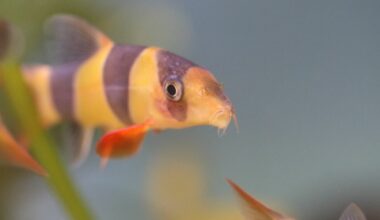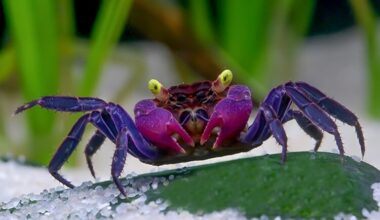If you’re an aquarium enthusiast looking to add a splash of vibrant color to your underwater haven, the orange shoulder tang is an excellent choice. With its striking appearance and captivating personality, this tropical fish has become a favorite among hobbyists.
In this care guide, we will explore the essential aspects of providing a comfortable and thriving environment for your orange shoulder tang, without diving into technical jargon. Whether you’re a beginner or a seasoned aquarist, this guide will equip you with the knowledge and tips to ensure the health and happiness of your orange shoulder tang, allowing you to enjoy its beauty and charm for years to come.
So, let’s dive in and discover the wonderful world of orange shoulder tang care together!
Table of Contents
Species Summary
Native to the Pacific, the Orange Shoulder Tang (Acanthurus olivaceus) is found swimming in the tropical waters off of Hawaii, Polynesia, the Philippines, and surrounding areas. These reef lovers are sometimes called orange-epaulette surgeonfish, orange shoulder surgeonfish, or orange band surgeonfish. An orange shoulder tang in the wild will generally stay on a reef unless it’s disturbed by a storm. In fact, this fish is known to love the “hiding spots” provided by reef life because it spooks quite easily.
What makes orange shoulder tangs so highly desired in aquariums? This fish is considered one of the hardier fish within the tang family that’s 86 species strong. A tang is a type of small, slightly round saltwater fish known for interesting colors and patterns.
Due to their semi-aggressive temperament and precise tank requirements, the orange shoulder tang is considered a “moderately difficult” fish for aquarium owners.
Author Note: Like all surgeonfish, the orange shoulder tang has a “sword” at the base of its tail that certainly can cause pain when handling this creature incorrectly! While the prick may be subtle, the potential for infection is real. Careful handling is always required.
Appearance
While tangs are known for their vibrant coloring and patterns in general, the orange shoulder tang species displays a relatively tame coloring among tangs. When orange shoulder tangs are juveniles, they have a yellow body with subtle orange markings at the shoulder.
In adulthood, these fish change to a two-tone blend of grey and blue. Under certain light conditions, you might notice a brown-to-olive hue coming through. The bright orange bar at the shoulder often becomes more pronounced with help from a newly developed dark gray/blue ring that can look nearly neon in certain light conditions.

Blue fringing on the fins is also quite attractive. While an orange shoulder tang may not overwhelm you with its bold, prismatic beauty the way something like a yellow tang would, this fish becomes more remarkable the longer you keep your gaze on it!
Lifespan
In captivity, an Orange Shoulder Tang has an average lifespan of 10 to 15 years and in the wild it is a totally different story. There are records of these tangs living up to 35 years!
Average Size
The Orange Shoulder Tang could reach an average size of 14 inches in adulthood. This can come as a shock to unprepared aquarium owners who purchase orange shoulder tangs at their juvenile size of 1.5 inches to 6 inches.
Generally, a female shoulder tang will grow to be an inch larger than her male counterpart. Females also grow much faster. An adult female orange shoulder tang will reach her full size by age 4.
Of course, healthy growth and development in an aquarium rests on the fact that a tang is being fed and cared for properly.
Orange Shoulder Tang Care
What kind of tank does it take to make an Orange Shoulder Tang happy? These creatures of habit love tons of open swimming space in an environment that recreates the natural reefs they cling to in the wild.
Tank Size
With the fact that these tangs can grow up to 14 inches in mind, it’s important to purchase a tank providing comfortable accommodations. In this case, the minimum tank size for an Orange Shoulder Tang is 135 gallons. Giving the tang more room to explore with a tank that’s 180 gallons or more is preferable. A tank should be at least 6 feet in length.
Author Note: Tangs are avid swimmers! When mature orange shoulder tangs aren’t provided with the space needed to swim, they are prone to aggression. You are also more likely to lose this species to stress-related sickness.
Water Parameters
The orange shoulder tang is considered a sensitive species. Ideal water parameters must be maintained for the health and wellness of this fish.
- Water temperature: 75°F to 82°F.
- Water pH levels: 8.1 to 8.4.
- Water hardness: 8 to 12 dKH.
- Specific gravity: 1.020 SG to 1.025 SG.
Tank Setup
With a reputation for being finicky, the orange shoulder tang demands a perfectly curated aquarium setting in order to thrive. While this fish needs open space to swim, it also craves caves and crevices for hiding. A sandy substrate also provides comfort by mimicking their natural habitat.
Here are some other points to cover when designing a tank habitat.
Lighting
Special lighting isn’t a requirement. As a tropical fish, the orange shoulder tang can potentially benefit from UV lighting in an aquarium. UV light also helps to sterilize tank water by killing viruses and parasites.
Filtration
Like all tropical fish, orange shoulder tangs require filtration systems that are rated for the size of the tank they are being housed in. In general, flow rate for a filtration system should be between four and six times the tank size. Measured in gallons per hour (GPH), flow rate for the minimum 135-gallon tank needed for orange shoulder tangs would be 540 GPH to 810 GPH.
Acclimation
How do you acclimate an orange shoulder tang? The standard “drip acclimation” method used for all saltwater fish should work perfectly fine for the orange shoulder tang. This involves allowing the bag of new fish to float in the aquarium for 15 to 30 minutes to start. Next, you will introduce existing aquarium water into the bag at a rate of around three to four drips per second. Kits can be purchased to make this process easier!
Author Note: Some people prefer to take this a step further by initially quarantining a tank that houses new fish for up to four weeks before introducing them to the general population of the new tank.
Are Orange Shoulder Tangs Reef-Safe?
This question has a bit of a mixed answer. Yes, Orange Shoulder Tangs are reef-safe fish as long as they are kept as well-fed fish! However, these fish won’t hesitate to nibble at coral when they feel hungry. Additionally, orange shoulder tangs that are housed in tanks that are too small will sometimes aggressively go after coral.
Common Possible Diseases & Prevention
While diseases and parasites aren’t necessarily common in orange shoulder tangs, the odds of encountering some sort of illness with this species is slightly higher when new fish being introduced to a tank were freshly caught in the wild. This is where the quarantine tank mentioned earlier in this article can be a good idea.
- Internal Parasites. These are among the most commonly seen diseases in Orange Shoulder Tangs. Common signs of parasites in tropical fish include erratic swimming, sluggishness, and loss of appetite.
- Ich. This illness is a parasitic skin disease also known as white spot disease, this condition often causes specks on the body and gills, loss of appetite, persistent hiding behaviors, and constant scraping of the body against objects in the tank.
- Marine Velvet. This is an infectious fish disease where you’ll notice what looks like a dusting of powdered sugar over the fins and body of the fish.
Author Note: Quarantining new introductions is one of the best ways to prevent disease in an aquarium environment. In addition, it’s important to inspect and monitor new fish before introducing them into the general population to spot signs of common diseases.
What do Orange Shoulder Tangs eat?
The Orange Shoulder Tang is omnivore so its diet consists of dried marine algae/dried seaweed. These fish also appreciate a little mysis shrimp (opossum shrimp/false shrimp) for protein. Flake food, spirulina, and frozen vegetables can also be part of a complete diet.
Orange Shoulder Tangs are a bit high maintenance since they should be fed three times per day.

Behavior & Temperament
Are orange shoulder tangs friendly? The truth is that the orange shoulder tang has a mildly aggressive temperament. Its personality is heavily dictated by its environment. A happy, well-fed orange shoulder tang generally doesn’t pick fights with other fish.
However, they are known to get along much better with other species compared to interactions with fellow tangs. The sharp, stabbing spine near the tail can certainly cut both fish and human companions when caution isn’t used!
Orange Shoulder Tang Tank Mates
Giving an orange shoulder tang the space it needs to swim around eagerly is the key to keeping peace in an aquarium! It’s generally recommended to avoid placing orange shoulder tangs with any other type of tang regardless of the expansiveness of a tank.
Author Note: If you’re going to attempt to make orange shoulder tangs mates, make sure you’re introducing them to the tank at exactly the same time. Bullying is likely when they cannot acclimate together.
Generally, an orange shoulder tang can coexist with any other fish that is known for its peaceful temperament such as the ones below.
- Clownfish
- Dottybacks
- Dwarf angelfish
- Dartfish
- Gobies (the Mandarin Goby is be one of them)
- Anthias
- Blennies like the Lawnmower Blenny or the Bicolor Blenny
- Damselfish
- Dartfish
Breeding
In the wild, the orange shoulder tang is what’s known as an egg scatterer. The female tang will inject her eggs near the water’s surface to allow them to be fertilized by males drifting by toward the surface.
One interesting tidbit on the orange shoulder tang is that this fish has never been successfully bred in captivity. The ones populating aquariums are wild-caught fish. However, other tangs like the Purple Tang and the Yellow Tang have successfully been bred in captivity.
Conclusion
In conclusion, caring for an Orange Shoulder Tang can be a rewarding and fulfilling experience for any fish enthusiast. With their vibrant colors and lively personalities, these beautiful creatures can truly enhance any aquarium.
By ensuring a spacious tank with plenty of hiding spots, maintaining pristine water quality, and offering a balanced diet, you can provide a comfortable and healthy environment for your orange shoulder tang. Additionally, regular observation and interaction with these fish can deepen your appreciation for the wonders of the underwater world.
We hope this care guide provided enough value for your future aquarium endeavors and as always, please feel free to reach out to us or maybe tag us on Facebook with a photo of your good looking fish 😉

